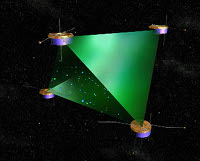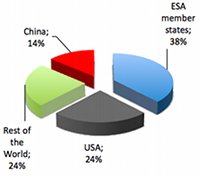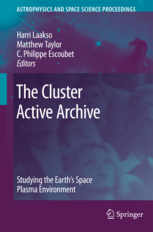The Cluster archive: more than 1000 users
3 June 2010
More than 1000 scientists are now registered to access the Cluster Active Archive (CAA), the online database of the Cluster mission. On average, the amount of data downloaded every month by these scientists exceeds 1 Terabyte.
 |
|
Data from the four Cluster spacecraft, depicted here flying in tetrahedron configuration, are contained in the Cluster Active Archive. Credit: ESA |
Currently, the CAA holds data for measurements obtained during the first 8 years of operations (2001-8), with the exception of a few datasets where the calibration work is still ongoing. Most of the observations performed in 2009 should be available from the CAA by the end of 2010.
All data products are freely available either via a user-friendly web interface, updated in March, or by using a command-line tool. All files are downloadable in either NASA Common Data Format (CDF) or in an ASCII format (called Cluster Exchange Format, or CEF) containing extensive metadata information; both are easily readable using standard scientific software.
So far, this represents more than 3.5 million files and 350 dataset types. Altogether, CAA offers the worldwide scientific community about 100 Terabytes (TB) of data with a quality suitable for science use and publication. By the end of the current expected mission (2012), it is anticipated that the database will consist of about 200 TB of data made up of about 10 million individual files, and the intention is to include all data from the Double Star mission as well.
The CAA also offers a plotting tool for a number of parameters. The user has an option to view pre-generated 1-hour, 6-hour or 24-hour plots (the fast option) or to select any interval up to 55 hours.
The number of individual scientists using CAA has steadily increased since 2006 when CAA went online. On 26 April 2010, it reached the milestone of 1000 active users.
|
|
|
|
Breakdown of CAA users by region. |
The Cluster Active Archive book. |
A book on the CAA was published in January 2010 by Springer. It is composed of 34 peer-reviewed articles about the CAA and its datasets, including a number of overview papers on the Cluster mission, descriptions of the measurement techniques and calibration routines that are used, the data analysis tools that are available, and recent original scientific findings.
The CAA serves a worldwide scientific community and plays an important role in facilitating multi-mission studies of the magnetosphere and its environment. "With respect to the level of effort that has gone into ensuring the documentation, calibration, validity, and usability of the data sets that it provides, the CAA is unparalleled", says Dr. David Sibeck, NASA THEMIS Project Scientist at the Goddard Space Flight Center. "The CAA enables researchers not only to conduct detailed studies of the superb high time- and spatial-resolution Cluster observations, but also to correlate these observations with those from a multitude of other missions and ground observatories. The CAA therefore represents a preeminent resource not only for researchers in Europe, but also space scientists throughout the world."
The CAA is unique among data archives in the discipline of space physics, in terms of the breadth, quantity and quality of the data that it contains. "A continuous process of review and modification has focused on making the CAA archive interface and data products as easy to use as possible. Alongside this, the inter-calibration workshops have challenged the instrument teams to ensure that the data are as self-consistent as possible. The CAA will be a fantastic resource for a long time into the future", comments Dr. Steve Milan, scientist at Leicester University, UK, and chair of the CAA review board.
"The most challenging part of archiving Cluster data is the instrument calibration aspect", says Dr. H. Laakso, the CAA Project Manager. "This is critical because the unique capability of the Cluster mission is measuring differences between the four spacecraft, and these differences are only meaningful in the context of well-understood cross-calibration."
The calibration of Cluster instruments is challenging because of the lack of absolute measurements that could provide reliable reference measurements. The instruments measure either electromagnetic fields and waves, or charged particles - all of which are invisible. Luckily, the Cluster spacecraft carry some instruments that can provide stable measurements with no significant instrumental offsets that can serve as reference data to other measurements. The calibration work is coordinated via the CAA cross-calibration workshops that are held every 6 months.
ESA's European Space Astronomy Centre (ESAC), near Madrid, Spain, hosts most of ESA's astronomy and planetary mission archives. This will also be the location of the Cluster data archive after the end of the Cluster mission operations, with a delay of one year when all data from the final year have been calibrated, produced and ingested into the database.
"CAA was proposed by Professor David Southwood, ESA Director of Science and Robotic Exploration, and approved by the ESA Science Programme Committee in 2003 as a major contribution to the International Living with a Star programme. Following the CAA opening in 2006, we have been happy to see a constant increase of the number of users from all over the world accompanied by a rise in the number of publications using CAA data", says Philippe Escoubet, ESA Cluster Mission Manager.
Reference
Laakso, H. et al. (Eds.), The Cluster Active Archive - Studying the Earth's Space Plasma Environment, 489 pages, Springer Netherlands, 2010. The book is available at: http://www.springer.com/content/book/978-90-481-3498-4.
About Cluster and Double Star
Launched in 2000, Cluster is the first space mission composed of four identical spacecraft orbiting the Earth in a tetrahedron configuration. Together, these spacecraft perform pioneering studies of the impact of the Sun on the Earth's space environment, in three dimensions. Cluster is a project of international cooperation between ESA and NASA.
Some of the Cluster flight spare instruments were also used to make up half of the scientific payload of the Double Star Programme (DSP): the first Chinese scientific space mission. DSP is composed of two spacecraft, launched in 2003 and 2004.
These two coordinated missions, Cluster and Double Star, have led to a wealth of scientific results published in more than 1200 peer-reviewed scientific articles.


